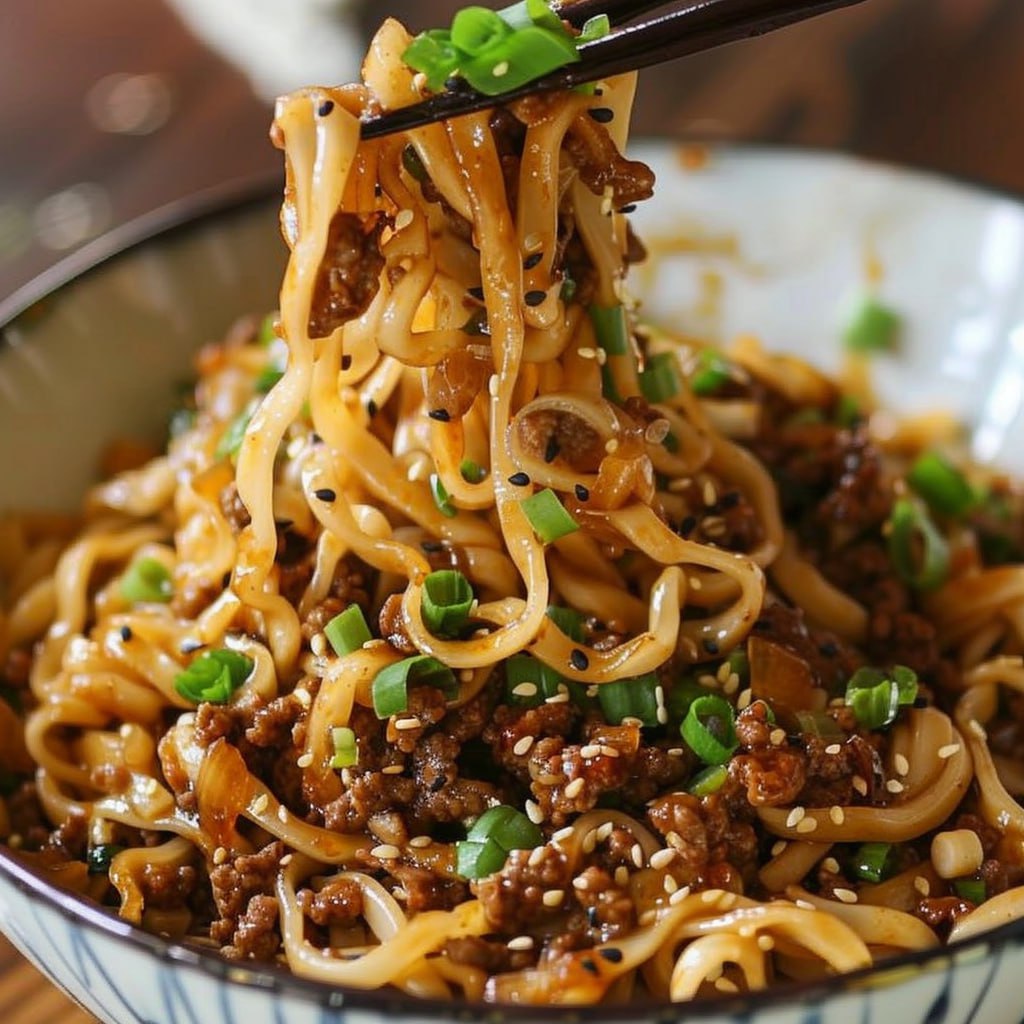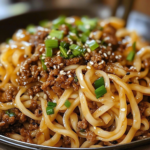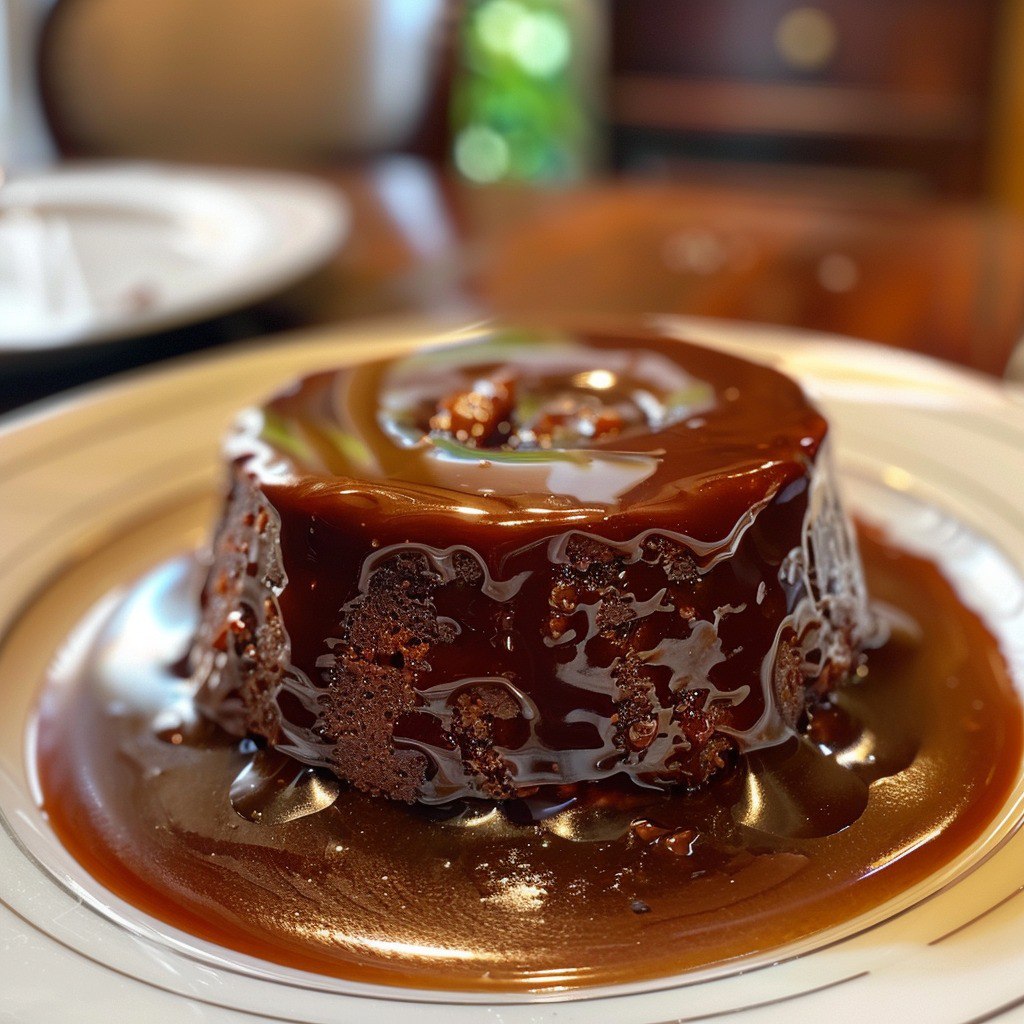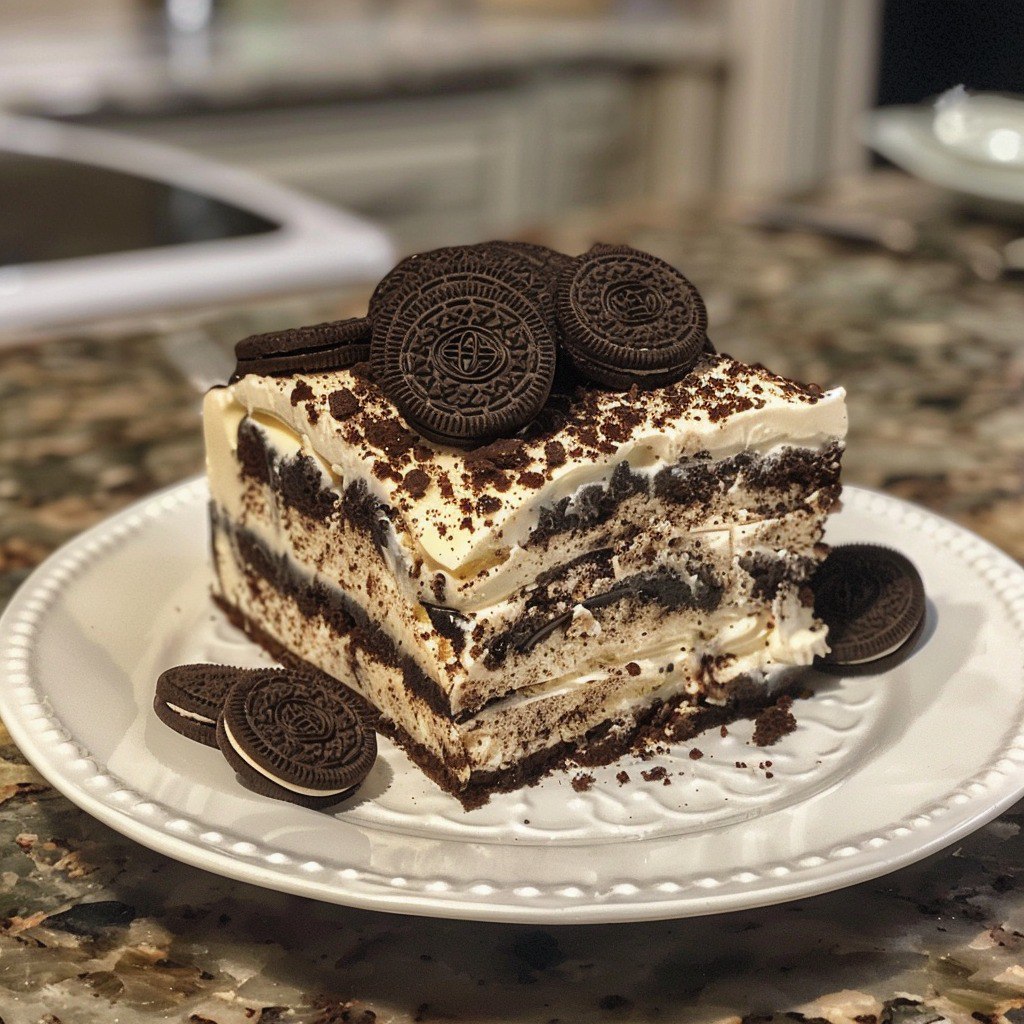Introduction
Searching for a satisfying weeknight dinner that combines bold Asian flavors with family-friendly appeal? Moreover, you’ve discovered the perfect solution with Mongolian Ground Beef Noodles – a dish that delivers restaurant-quality taste in just 30 minutes. This savory masterpiece features tender ground beef, perfectly seasoned noodles, and a rich sauce that brings everything together beautifully.
Furthermore, this recipe transforms simple pantry staples into an extraordinary meal that rivals your favorite takeout restaurant. Additionally, the combination of soy sauce, brown sugar, and aromatic spices creates that signature sweet-savory balance that makes Mongolian cuisine so irresistible. Best of all, you can customize this dish to match your family’s spice preferences and dietary needs.
Why You’ll Love This Mongolian Ground Beef Noodles Recipe
Creating authentic Mongolian Ground Beef Noodles at home offers numerous advantages over ordering takeout or struggling with complicated recipes. Moreover, this dish strikes the perfect balance between convenience and exceptional flavor that busy families desperately need.
It’s incredibly quick and easy:
- Ready in just 30 minutes from start to finish
- Uses simple cooking techniques anyone can master
- Requires only one skillet for minimal cleanup
It’s budget-friendly and practical:
- Ground beef costs less than premium steak cuts
- Uses pantry staples you likely already have
- Feeds 4-6 people for under $15 total
It’s wonderfully versatile:
- Easily customizable for different spice levels
- Works with various noodle types and substitutions
- Perfect for meal prep and leftover lunches
It’s universally appealing:
- Kid-friendly flavors without overwhelming heat
- Satisfies adult cravings for bold, complex tastes
- Great for entertaining or casual family dinners
Additionally, this recipe provides complete protein and carbohydrates in one satisfying dish. Furthermore, the sauce delivers umami-rich flavors that make vegetables more appealing to picky eaters. Moreover, leftover portions reheat beautifully for convenient lunch options throughout the week.
Essential Ingredients for Perfect Mongolian Ground Beef Noodles
Understanding each component helps you create the most flavorful Mongolian Ground Beef Noodles possible. Furthermore, quality ingredients make a significant difference in achieving authentic restaurant-style results.
Protein Foundation:
- 1 lb ground beef (80/20 blend recommended)
- Excess fat for draining after browning
Noodle Base:
- 8 oz rice noodles or spaghetti
- Salted water for proper pasta cooking
Sauce Components:
- 1/2 cup soy sauce (low-sodium preferred)
- 1/4 cup brown sugar (packed measurement)
- 1/2 cup beef broth (low-sodium variety)
- 2 tbsp hoisin sauce for depth
Aromatics and Thickening:
- 3 cloves garlic, minced fresh
- 1 tbsp fresh ginger, minced fine
- 1 tbsp cornstarch mixed with 2 tbsp water
Finishing Touches:
- 4 green onions, chopped diagonally
- Sesame seeds for authentic garnish
Ground beef with 80/20 fat content provides the ideal balance of flavor and moisture. However, leaner options work well if you prefer reduced fat content. Additionally, the fat adds richness to the sauce, so don’t choose overly lean varieties.
Fresh garlic and ginger create the aromatic foundation that distinguishes authentic Asian flavors. Moreover, pre-minced versions lack the intensity of fresh ingredients. Furthermore, proper mincing releases maximum oils for optimal flavor development.
Step-by-Step Guide to Making Mongolian Ground Beef Noodles
Step 1: Preparing Your Noodles Foundation
Begin your Mongolian Ground Beef Noodles by bringing a large pot of salted water to rolling boil. Additionally, generous salt seasoning ensures the noodles absorb flavor from within. Furthermore, properly salted water prevents bland pasta that relies entirely on external sauce for taste.
Cook the rice noodles or spaghetti according to package instructions for al dente texture. However, test one minute before the recommended time since noodles continue cooking slightly after draining. Moreover, overcooked noodles become mushy when combined with the sauce.
Reserve one cup of pasta cooking water before draining completely. Additionally, this starchy liquid helps adjust sauce consistency if needed later. Furthermore, the salted, starchy water integrates better than plain water for thinning purposes.
Drain the noodles thoroughly and set aside in a large bowl. However, don’t rinse them since the surface starch helps sauce adherence. Additionally, toss with a small amount of oil if not using immediately to prevent sticking.
Step 2: Browning the Ground Beef Perfectly
Heat a large skillet over medium heat while your noodles finish cooking. Additionally, the pan should be large enough to accommodate all ingredients without overcrowding. Furthermore, proper pan size ensures even cooking and prevents steaming instead of browning.
Add the ground beef to the heated skillet, breaking it apart with a wooden spoon. Moreover, avoid pressing the meat flat, which prevents proper browning and flavor development. Additionally, let the beef cook undisturbed for 2-3 minutes before stirring for better searing.
Continue cooking while stirring occasionally until the beef browns completely and no pink remains. Furthermore, proper browning creates fond (browned bits) on the pan bottom that adds incredible flavor to your sauce. Additionally, this process typically takes 6-8 minutes depending on your stove’s heat output.
Drain excess fat from the skillet, reserving about one tablespoon for flavor. However, removing most fat prevents greasy sauce while maintaining richness. Moreover, lean ground beef may not produce much excess fat to drain.
Step 3: Building Aromatic Flavor Base
Add the minced garlic and fresh ginger to the skillet with the browned beef. Additionally, these aromatics need brief cooking to release their essential oils without burning. Furthermore, burnt garlic creates bitter flavors that ruin the entire dish.
Cook the garlic and ginger for 1-2 minutes until fragrant, stirring constantly to prevent burning. Moreover, you’ll know they’re ready when the aroma becomes noticeably stronger and more complex. Additionally, the mixture should sizzle gently without browning significantly.
This aromatic base forms the foundation for authentic Mongolian Ground Beef Noodles flavor. Furthermore, fresh ingredients provide intensity that dried or pre-minced alternatives cannot match. Moreover, proper technique here determines whether your final dish tastes homemade or restaurant-quality.
Step 4: Creating the Signature Mongolian Sauce
Combine the soy sauce, brown sugar, beef broth, and hoisin sauce in a mixing bowl. Additionally, whisk thoroughly to dissolve the brown sugar completely before adding to the hot skillet. Furthermore, undissolved sugar can create lumpy, uneven sweetness in the final dish.
Pour the sauce mixture into the skillet with the beef and aromatics. Moreover, the liquid will bubble vigorously when it hits the hot pan, so add it gradually. Additionally, stir immediately to incorporate all the browned bits from the pan bottom for maximum flavor.
Bring the sauce to a gentle simmer, not a rolling boil that might cause separation. Furthermore, simmering allows the flavors to meld while beginning the thickening process. Additionally, taste and adjust seasoning at this point since salt levels vary between soy sauce brands.
The sauce should reduce slightly and begin coating the beef after 2-3 minutes of simmering. However, if it seems too thin, continue cooking briefly before adding the thickening agent. Moreover, proper reduction concentrates flavors for more intense taste.

Step 5: Thickening and Final Assembly
Mix the cornstarch with cold water in a small bowl until completely smooth. Additionally, this slurry must be lump-free to prevent lumpy sauce texture. Furthermore, cold water prevents the cornstarch from cooking prematurely and becoming ineffective.
Add the cornstarch slurry to the simmering sauce while stirring constantly. Moreover, the sauce should thicken noticeably within 30-60 seconds of addition. Additionally, continue stirring to ensure even distribution and prevent lumps from forming.
Add the cooked noodles to the skillet and toss gently to coat evenly with sauce. However, use tongs or chopsticks to prevent breaking the noodles during mixing. Furthermore, every strand should be coated with the glossy, flavorful sauce for optimal results.
Stir in the chopped green onions and cook for 1-2 minutes until slightly wilted. Additionally, green onions provide fresh flavor and attractive color contrast to the rich brown sauce. Moreover, brief cooking softens their bite while maintaining some texture and freshness.
Pro Tips for Restaurant-Quality Mongolian Ground Beef Noodles
Meat Selection and Preparation
Choose ground beef with appropriate fat content for your Mongolian Ground Beef Noodles preferences. Additionally, 80/20 ground beef provides ideal flavor and moisture balance. However, 85/15 works well for those preferring leaner options while maintaining good taste.
Let the meat come to room temperature before cooking for more even browning. Furthermore, cold meat from the refrigerator can cause uneven cooking and temperature drops in your pan. Additionally, room temperature meat sears better and develops superior flavor.
Avoid over-mixing or pressing the meat while browning, which creates dense, tough textures. Instead, break it apart gently and let it brown undisturbed between stirring sessions. Moreover, proper technique creates tender, flavorful beef that enhances the overall dish quality.
Sauce Balance and Customization
Taste your sauce before adding the noodles to ensure proper sweet-savory balance. Additionally, soy sauce saltiness varies between brands, affecting overall flavor profile. Furthermore, brown sugar sweetness can be adjusted to match your family’s preferences perfectly.
For spicier Mongolian Ground Beef Noodles, add red pepper flakes or sriracha to the sauce mixture. However, start with small amounts since heat levels vary significantly between products. Moreover, you can always add more heat but cannot remove excess spiciness.
Consider adding sesame oil at the end for authentic nutty flavor enhancement. Furthermore, a small drizzle provides aromatic complexity that elevates the dish significantly. Additionally, toasted sesame oil works better than regular sesame oil for this application.
Noodle Selection and Cooking
Rice noodles provide the most authentic texture for Mongolian cuisine applications. However, regular spaghetti or linguine work excellently as substitutes in most grocery stores. Additionally, whole wheat pasta adds fiber and nutrients while maintaining good sauce adherence.
Fresh noodles cook faster than dried varieties, so adjust timing accordingly. Moreover, fresh pasta typically requires only 2-3 minutes in boiling water compared to 8-12 minutes for dried. Furthermore, watch carefully to prevent overcooking, which ruins texture completely.
Rinse rice noodles briefly with cold water after cooking to prevent overcooking from residual heat. However, don’t rinse wheat-based pasta, which removes surface starch needed for sauce binding. Additionally, different noodle types require different handling techniques for optimal results.
Creative Variations for Your Mongolian Ground Beef Noodles
Vegetable Additions
Enhanced Mongolian Ground Beef Noodles benefit from colorful vegetable additions that boost nutrition and visual appeal. Snap peas provide satisfying crunch and bright green color when added during the final cooking minutes. Additionally, they maintain their texture while absorbing sauce flavors beautifully.
Bell peppers in red, yellow, or orange create stunning color contrast while adding sweet, mild flavor. Moreover, slice them into thin strips for quick cooking and attractive presentation. Furthermore, add them with the aromatics for proper cooking time without becoming mushy.
Broccoli florets work excellently when blanched separately and added at the end. Additionally, this prevents overcooking while ensuring proper texture retention. Moreover, the trees catch and hold sauce effectively for flavorful bites throughout the dish.
Baby corn and water chestnuts provide authentic Asian flavors and interesting textures. Furthermore, these ingredients are often found in traditional Mongolian-style dishes at restaurants. Additionally, they add visual interest and satisfying crunch that contrasts nicely with tender noodles.
Protein Alternatives
Ground turkey creates a leaner version of Mongolian Ground Beef Noodles while maintaining excellent flavor absorption. However, turkey requires slightly different cooking techniques due to lower fat content. Additionally, avoid overcooking, which can make turkey dry and less appealing.
Ground pork provides rich flavor that pairs beautifully with the sweet-savory sauce profile. Moreover, pork’s natural sweetness complements the brown sugar component particularly well. Furthermore, it browns excellently and creates flavorful fond for sauce enhancement.
Diced chicken thighs offer tender, juicy results that work wonderfully in this application. Additionally, dark meat stays moist during quick cooking methods better than breast meat. However, ensure pieces are uniform size for even cooking throughout the dish.
For vegetarian versions, crumbled extra-firm tofu or plant-based ground meat substitutes work successfully. Furthermore, press tofu thoroughly to remove moisture before crumbling and browning. Additionally, season well since these proteins absorb flavors differently than meat.
International Fusion Ideas
Korean-inspired Mongolian Ground Beef Noodles incorporate gochujang paste for complex heat and fermented flavors. Additionally, kimchi added at the end provides probiotics and tangy contrast to rich sauce. However, drain kimchi thoroughly to prevent excess liquid from thinning the sauce.
Thai fusion versions benefit from fish sauce addition and fresh basil finishing. Moreover, lime juice brightens the overall flavor profile significantly. Furthermore, crushed peanuts provide textural interest and authentic Southeast Asian appeal.
Mexican-influenced variations incorporate cumin and chili powder in the beef browning stage. Additionally, fresh cilantro and lime create bright finishing notes. Moreover, jalapeños add heat while maintaining the dish’s essential character and appeal.
Common Mistakes to Avoid When Making Mongolian Ground Beef Noodles
Cooking Temperature Errors
Excessive heat during beef browning creates tough, dry meat that detracts from your Mongolian Ground Beef Noodles quality. However, insufficient heat prevents proper browning and flavor development. Therefore, medium heat provides the ideal balance for optimal results.
Boiling the sauce vigorously can cause separation and uneven thickening that ruins texture completely. Instead, maintain gentle simmering throughout the sauce cooking process. Additionally, vigorous boiling can make cornstarch thickening less effective and create lumpy results.
Adding cold ingredients to hot pans causes temperature drops that affect cooking consistency. Furthermore, room temperature ingredients integrate more smoothly and cook more evenly. Moreover, extreme temperature differences can cause sauces to break or separate unexpectedly.
Sauce Consistency Problems
Adding too much cornstarch slurry creates overly thick, gummy sauce that coats unpleasantly. However, insufficient thickening leaves watery sauce that doesn’t adhere to noodles properly. Therefore, add the slurry gradually while stirring to achieve perfect consistency.
Forgetting to dissolve brown sugar completely creates grainy, uneven sweetness throughout the dish. Moreover, undissolved sugar can burn on the pan bottom, creating bitter flavors. Additionally, thorough mixing before heating prevents these texture and flavor problems.
Skipping the sauce reduction step results in weak flavors that don’t satisfy expectations. Furthermore, proper simmering concentrates flavors while creating the right consistency naturally. Additionally, rushed cooking produces inferior results compared to patient technique.
Timing and Assembly Issues
Overcooking noodles before adding to the sauce creates mushy, unappetizing texture that ruins the dish. However, undercooking prevents proper sauce absorption and integration. Therefore, aim for al dente texture that finishes cooking in the sauce.
Adding green onions too early causes them to become slimy and lose their fresh flavor contribution. Instead, add them during the final minutes for optimal texture and taste. Additionally, reserve some for fresh garnish to maintain color and crunch.
Letting the completed dish sit too long before serving allows noodles to absorb excess sauce and become soggy. Moreover, Mongolian Ground Beef Noodles taste best when served immediately while hot and properly sauced. Furthermore, prompt serving maintains optimal texture and temperature.
Storage and Reheating Your Mongolian Ground Beef Noodles
Proper Storage Techniques
Store leftover Mongolian Ground Beef Noodles in airtight containers in the refrigerator for up to four days. However, the noodles will continue absorbing sauce during storage, changing the texture slightly. Additionally, proper containers prevent odor transfer and maintain food safety standards.
Divide large portions into smaller containers for faster cooling and more convenient reheating portions. Furthermore, shallow containers cool more quickly and evenly than deep ones. Moreover, individual portions make grab-and-go lunches incredibly convenient for busy schedules.
Label containers with contents and date to track freshness accurately. Additionally, this prevents forgotten leftovers from spoiling in the back of your refrigerator. Furthermore, proper labeling helps with meal planning and reduces food waste significantly.
Successful Reheating Methods
Stovetop reheating provides the best results for maintaining Mongolian Ground Beef Noodles texture and flavor. Add a splash of beef broth or water to restore proper moisture levels. Additionally, gentle heat prevents overcooking while ensuring thorough warming throughout.
Microwave reheating works for individual portions but requires careful attention to prevent drying. However, use reduced power settings and stir frequently for even heating. Furthermore, cover the container to retain moisture and prevent spattering during heating.
Add fresh green onions and sesame seeds after reheating to restore color and texture appeal. Moreover, these garnishes provide fresh flavor that compensates for any taste changes during storage. Additionally, fresh elements make reheated portions nearly indistinguishable from freshly prepared dishes.
Nutritional Information and Health Benefits
Macronutrient Breakdown
Each serving of Mongolian Ground Beef Noodles provides approximately 350 calories with balanced macronutrients for satisfaction. Additionally, the dish contains roughly 25 grams of protein from the ground beef component. Furthermore, carbohydrates from noodles provide energy while the sauce adds minimal fat content.
Protein content supports muscle maintenance and provides lasting satiety between meals. Moreover, complete proteins from beef contain all essential amino acids needed for optimal health. Additionally, proper protein intake helps regulate appetite and supports weight management goals.
Carbohydrates from noodles provide quick energy for active lifestyles and growing children. However, the glycemic impact remains moderate due to protein and fat content that slow digestion. Furthermore, rice noodles offer gluten-free options for those with dietary restrictions.
Micronutrient Contributions
Ground beef provides significant amounts of iron, zinc, and B-vitamins essential for energy metabolism. Additionally, these nutrients support immune function and cognitive performance. Moreover, heme iron from meat absorbs more efficiently than plant-based iron sources.
Ginger and garlic offer antioxidant compounds that support overall health and immune function. Furthermore, these aromatics provide anti-inflammatory benefits beyond their flavor contributions. Additionally, regular consumption may support cardiovascular health and digestion.
Green onions contribute vitamin K, vitamin C, and folate to your nutritional intake. Moreover, these nutrients support bone health and immune function effectively. Additionally, the fresh garnish provides minimal calories while maximizing nutritional density.
Dietary Modifications
Create gluten-free Mongolian Ground Beef Noodles by using rice noodles and ensuring all sauce ingredients are certified gluten-free. However, check soy sauce labels carefully since many contain wheat products. Additionally, tamari provides excellent gluten-free soy sauce alternative with similar flavor.
Reduce sodium content by using low-sodium soy sauce and beef broth throughout the recipe. Furthermore, increase aromatics like ginger and garlic to maintain flavor intensity with less salt. Additionally, fresh herbs provide flavor complexity without additional sodium content.
Lower-carbohydrate versions can substitute spiralized vegetables or shirataki noodles for traditional pasta. However, expect different textures and adjust cooking times accordingly. Moreover, these alternatives significantly reduce caloric and carbohydrate content while maintaining satisfying portions.
Frequently Asked Questions About Mongolian Ground Beef Noodles
Can I make Mongolian Ground Beef Noodles without hoisin sauce?
Yes, you can substitute hoisin sauce with additional soy sauce and brown sugar in your Mongolian Ground Beef Noodles. However, hoisin provides complex umami flavors that simple substitutions cannot fully replicate. Additionally, try adding a small amount of peanut butter or sesame paste for depth.
Furthermore, oyster sauce offers similar thickness and complexity if available in your pantry. Moreover, it provides the glossy finish and rich flavor that makes the dish special. However, vegetarian versions should avoid oyster sauce due to seafood content.
How do I prevent my noodles from getting mushy?
Cook noodles just to al dente stage before adding to your Mongolian Ground Beef Noodles sauce mixture. Additionally, they’ll finish cooking in the sauce, so undercooking initially prevents mushiness. Furthermore, remove from heat immediately once properly coated with sauce.
Moreover, serve immediately after combining to prevent over-absorption of sauce by the noodles. However, if you must hold the dish, add extra broth to compensate for continued absorption. Additionally, gentle reheating helps restore proper texture if noodles become too soft.
Can I prepare this dish in advance?
While Mongolian Ground Beef Noodles taste best served immediately, you can prep components separately for quick assembly. Additionally, cook and season the ground beef mixture, then store refrigerated for up to three days. However, cook noodles fresh for optimal texture results.
Furthermore, the sauce mixture can be prepared and stored separately from other components. Moreover, combine everything just before serving to maintain proper textures throughout. Additionally, fresh garnishes should always be added at serving time for best appearance and flavor.
What’s the best way to adjust spice levels?
Start with the basic Mongolian Ground Beef Noodles recipe, then add heat gradually to taste preferences. Additionally, red pepper flakes provide controllable heat that distributes evenly throughout the dish. Furthermore, sriracha or garlic chili sauce offer more complex heat profiles.
Moreover, balance increased heat with additional brown sugar to maintain the characteristic sweet-savory profile. However, taste frequently while adjusting to prevent overwhelming the dish’s fundamental flavors. Additionally, serve hot sauce on the side for individual customization.
Can I use different types of ground meat?
Ground turkey, pork, or chicken work excellently in Mongolian Ground Beef Noodles with minor technique adjustments. However, leaner meats like turkey may require additional fat for proper browning and flavor. Additionally, cooking times may vary slightly depending on fat content differences.
Furthermore, ground lamb provides rich, distinctive flavor that pairs beautifully with the sweet-savory sauce profile. Moreover, it browns excellently and creates delicious fond for sauce enhancement. However, expect more intense flavor than traditional beef versions.
Meal Planning and Serving Suggestions
Complete Menu Integration
Serve Mongolian Ground Beef Noodles as the centerpiece of an Asian-inspired dinner menu. Additionally, start with light appetizers like spring rolls or pot stickers to maintain the theme. Furthermore, steamed dumplings provide satisfying starters that don’t compete with the main dish’s richness.
Moreover, complement the meal with simple stir-fried vegetables like bok choy or snow peas. However, keep vegetable preparations light since the noodle dish provides substantial satisfaction. Additionally, steamed broccoli or green beans offer color and nutritional balance without overwhelming flavors.
Fresh fruit desserts like sliced oranges or pineapple provide cleansing finishes after rich main courses. Furthermore, these options aid digestion while providing refreshing contrast to savory flavors. Additionally, green tea serves as an authentic beverage pairing that aids digestion naturally.
Weekly Meal Prep Applications
Mongolian Ground Beef Noodles work excellently for weekly meal preparation when stored and reheated properly. Additionally, prepare large batches on weekends for convenient weekday lunches and dinners. However, store noodles and sauce separately when possible for optimal reheating results.
Furthermore, portion individual servings in microwave-safe containers for grab-and-go convenience. Moreover, add fresh garnishes to each portion just before eating to maintain color and texture appeal. Additionally, prepare extra sauce separately for those who prefer saucier portions.
Consider doubling the recipe and freezing half for later use in busy weeks. However, freeze sauce and meat mixture separately from noodles for best results. Additionally, cook fresh noodles when ready to serve the frozen components for optimal texture.
Conclusion
Mastering Mongolian Ground Beef Noodles at home brings authentic Asian flavors to your family table while providing convenient weeknight meal solutions. Moreover, this versatile recipe adapts easily to different dietary needs, spice preferences, and available ingredients. Additionally, the quick cooking time makes it perfect for busy schedules without sacrificing flavor or satisfaction.
Furthermore, understanding proper techniques for each component ensures consistent, restaurant-quality results every time you prepare this beloved dish. The combination of savory ground beef, perfectly cooked noodles, and that signature sweet-savory sauce creates comfort food that appeals to all ages. Additionally, the recipe’s flexibility allows endless customization possibilities for adventurous home cooks.
Print
The Ultimate Guide to Mongolian Ground Beef Noodles: A Quick and Delicious Weeknight Meal
- Total Time: 25 MINS
Description
Savor the rich, savory flavors of Mongolian Ground Beef Noodles! This quick and easy dish combines tender beef, flavorful sauce, and noodles for a satisfying meal the whole family will love.
Ingredients
1 lb ground beef
8 oz rice noodles or spaghetti
1/2 cup soy sauce
1/4 cup brown sugar
3 cloves garlic, minced
1 tbsp fresh ginger, minced
1/2 cup beef broth
2 tbsp hoisin sauce
1 tbsp cornstarch mixed with 2 tbsp water
4 green onions, chopped
Sesame seeds for garnish
Instructions
Cook the noodles according to package instructions. Drain and set aside.
In a large skillet, cook the ground beef over medium heat until browned. Drain any excess fat.
Add the minced garlic and ginger to the skillet and cook for 1-2 minutes until fragrant.
In a bowl, mix the soy sauce, brown sugar, beef broth, and hoisin sauce. Pour the mixture into the skillet with the beef.
Bring the sauce to a simmer and add the cornstarch slurry. Stir until the sauce thickens.
Add the cooked noodles to the skillet and toss to coat evenly with the sauce.
Stir in the chopped green onions and cook for another 1-2 minutes.
Garnish with sesame seeds and serve hot.
Prep Time: 15 minutes




